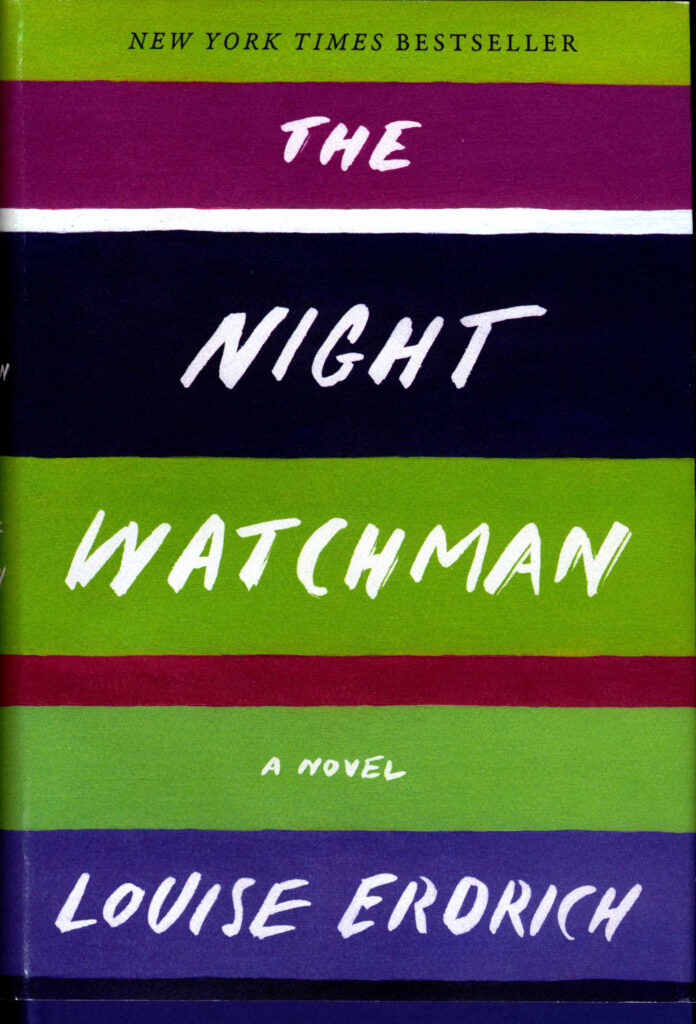Harpers Collins, 2021 Paperback: $18
Reviewed by Candace Black

Fans of Louise Erdrich know what to anticipate with The Night Watchman, her Pulitzer Prize-winning 17th novel: multiple and compelling plotlines seamlessly woven together, an abundance of memorable characters, and humor, both subtle and laugh-out-loud. Based on her maternal grandfather’s experiences in the mid-1950s, it rewards readers’ expectations as its shifting points of view recount historic challenges to native peoples’ survival, community, and identity that are just as current in the 21st Century.
Thomas Wazhashk must fight against House Concurrent Resolution 108, a bill that would eventually terminate all American Indians’ tribal status, and immediately terminate his own—the Turtle Mountain Band of Chippewa. Chairman of the Turtle Mountain Advisory Committee, he is of the “after-the-buffalo-who-are-we-now generation,” living all his life, except for a miserable time at a government boarding school, on the reservation. He values and practices traditional ways (like his beloved father, Biboon, and his cousin Zhaanat Paranteau, whose knowledge of ceremonies and teaching stories had been “considered so important she had been hidden, guarded against going to boarding school”) while holding the titular position at the new jewel bearing plant that provides much-needed jobs nearby. He’s proud of the used car he can now afford, and dreams of the plumbing he wants to install in the family’s pre-fab government house—what the bill interprets as signs of assimilation and success, reasons “to unmake, to unrecognize, to erase … as if we were never here, from the beginning, here.” He musters support from wherever he can find it—tribal members, political figures, ghosts of friends, and even the shining people of the northern lights—to maintain his people’s identity because survival, as Biboon says, “is a changing game.”
Patrice Paranteau, Zhaanat’s daughter, also fights, for the survival of her family. She protects her mother and younger brother from her father’s drunken rages. She travels to Minneapolis in search of her older sister Vera, who’s disappeared since moving there under the auspices of the Placement and Relocation Office (another government attempt “to solve Indians”). Some details of her search are comically classic Erdrich—two bumbling kidnappers, Freckle Face and Dinky; a gig dancing underwater in a blue rubber ox suit at a lumberjack-themed bar; a gallant junkie—but Patrice is in danger, and stumbles into clues that point to violence and sex trafficking. She returns to the reservation and her “white-people” job at the plant; without Vera, but with her sister’s infant son. A recent high school valedictorian trying to shed her childhood name, Pixie, she feels the weight of choices newly available to her and women of her mid-century generation. Settle down with one of two willing suitors (well-intentioned but naively ignorant Lloyd “Hay Stack” Barnes, white math teacher at the reservation high school, or handsome half-Sioux pugilist Wood Mountain Blue)? Continue working at the plant and provide for her family? Attend college? Not all of these questions are answered by the end of the book, but Patrice has newfound strengths to explore her options.
Erdrich creates secondary (and tertiary!) characters who are just as compelling and complex as Thomas and Patrice. Cafeteria cook Juggie Blue, horse breeder Louis Pipestone, college student Millie Cloud, the young boxers “Hay Stack” Barnes trains after school, the women Patrice works with at the plant, Edith the psychic dog, Roderick the ghost. Each contributes to the protagonists’ efforts. One hopes Erdrich will revisit them in future fiction, as she did with characters in several of her earlier novels.
Characters grapple with serious issues like systemic racism, tribal termination, alcohol abuse, and sex trafficking—all of which are not merely historic problems but regrettably contemporary—but Erdrich provides comic relief in characters’ thoughts, actions and conversations. Vernon and Elnath, the hapless Mormon missionaries who parallel Freckle Face and Dinky—we laugh at them, even while recognizing the damage they inflict as pawns of the powerful forces behind them. Because tragedy and comedy co-exist, often face each other. This mirroring occurs literally in The Night Watchman—characters looking at themselves as they shave or apply makeup—but also in similar situations or choices that dovetail throughout the novel. To point them out now would ruin a future reader’s discovery, but they satisfy and contribute to yet another welcome Erdrich saga from the Indian Country.